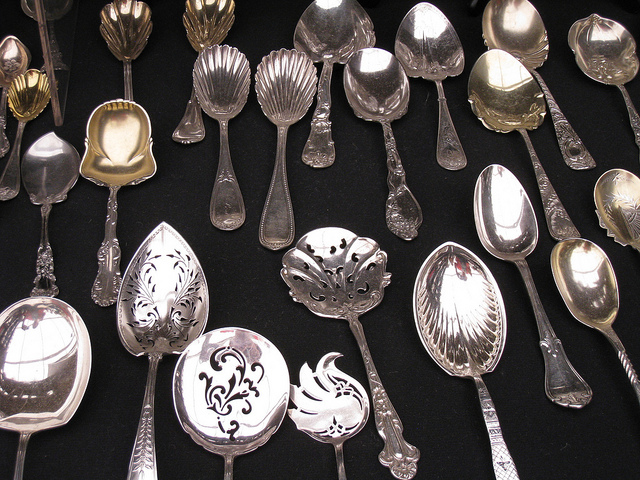Beautiful silver spoons on display at Round Top Antique Week (in and near Round Top, TX); photo by MyEyeSees on Flickr (noncommercial use permitted with attribution / no derivative works).
Official State Precious Metal of Texas
Texas designated silver as the official state precious metal in 2007. All State Minerals
HOUSE CONCURRENT RESOLUTION (H.C.R. No. 102).
WHEREAS, The State of Texas has customarily recognized a variety of official symbols as tangible representations of the state's culture and history; and
WHEREAS, The precious metal silver has played a prominent role in the story of the Lone Star State, and it continues to be a visible part of Texas culture, reflecting the enduring influence of Spanish colonial design and the western heritage that is so much a part of the state's lore; and
WHEREAS, Silver has been mined in Texas for more than three centuries, beginning shortly after the Spanish established their first permanent settlements in the area in the late 1600s; the first mines were founded by Franciscan friars who dug for silver deposits near El Paso, and these same sites were worked periodically for the next 200 years; and
WHEREAS, In the late 1800s, prospectors began exploring other parts of West Texas, with figures such as John W. Spencer, Samuel B. Buckley, Lieutenant John L. Bullis, and Colonel William R. Shafter focusing their efforts on Presidio County; this led to the opening of the Shafter Mining District, which was the site of the famous Presidio Mine; operated between 1884 and 1947, it produced more than 90 percent of all the silver that has ever been mined in Texas and became a prominent business that spurred greater development in the Big Bend region; and
WHEREAS, Other mining districts in the state also yielded silver; Hudspeth and Culberson Counties were home to the Van Horn-Allamoore and the Plata Verde Districts, and Hudspeth County also contained the Quitman Mountains District; in addition, Brewster County was the site of the Altuda Mountain District, and mining took place at locations in Llano, Mason, and Gillespie Counties in the Hill Country; in total, Texas mines yielded more than 33 million fine ounces of silver, which had a value of nearly $23.5 million, between 1885 and 1952; the manual labor of carving these riches from the rocks fell to a hardy group of miners who, in true Texan fashion, used their skill and determination to complete a difficult and dangerous job; and
WHEREAS, Most mining came to an end in the 1950s, but interest in harvesting the state's silver deposits continues; 20 million troy ounces of the metal are believed to still remain in the Shafter Mining District, and resources of this kind may prove profitable given silver's widespread use in commercial and industrial applications, where it plays a role in everything from photography to coin making, x-rays, water treatment, and electronics; and
WHEREAS, Jewelry makers and other artisans also rely on this precious metal, and the stately sheen of silver is a key element in beautiful stylistic designs, both rustic and refined, that can be seen throughout Texas; in belt buckles, tie clasps, and boot decorations, it is a staple of the western-wear fashions that harken back to the state's pioneer past; moreover, silver's rich, pure luster also makes it a favorite material for religious jewelry and other devotional objects, as well as any item or decoration that may benefit from its luxurious, glittering hues; and
WHEREAS, In both its historical and economic significance and its enduring connections to Texas imagery and culture, silver is a fitting symbol for the state and its people, and it is indeed appropriate that this metal receive special legislative recognition; now, therefore, be it
RESOLVED, That the 80th Legislature of the State of Texas hereby designate silver as the official precious metal of Texas.

